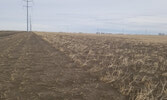By Madeleine Baerg
When the wind picks up and the sky turns grey with blow-dirt, everyone loses.
For the farmer whose field seems suddenly half in the air, the economic impact of a major wind event can be nothing short of devastating.
"The topsoil is the most productive strip of soil. Losing any amount of topsoil disproportionately impacts productivity, even if there is a decent amount of topsoil," explains Gurbir Dhillon, a research scientist at Farming Smarter in Lethbridge.
Unfortunately, we need more research to account for the many field condition variables that make an effective assessment of wind erosion's actual costs at the farm level, says Dhillon. That said, he says some past studies can provide some guidance, including a study conducted in the 1990s by AAFC soil conservation research scientist Dr. Frank Larney that showed a yield drop of 40% when a two-inch layer of topsoil was stripped from a wheat plot.
Wind selectively removes soil's fine mineral particles, clay and organic matter. The loss of these soil components dramatically impacts the remaining soil's water infiltration and water holding capacity. It leads to increased soil crusting, run-off, and water erodibility. It also decreases soil's capacity to attract and retain positively charged molecules including nutrients, herbicides, etc. Together, all of these factors reduce soil fertility and productivity.
Wind also costs nutrient availability. Since some nutrients attach themselves to clay or organic matter, a farmer's nutrients will hitch a ride out of the field when the soil blows. Too, losing organic matter means a corresponding loss of nutrients that would otherwise have become available through natural decomposition of that organic matter.
Canadian Perspective
Taken across all Canadian agriculture, the costs are very significant.
"It's hard to quantify the losses but studies suggest that the loss of soil from erosion has negatively impacted [Canadian crop] yields by 5 to 10%," says Dhillon.
In 2019 University of Manitoba researcher Dr. David Lobb reported that erosion losses of all kinds (wind, water and tillage erosion combined) cost Canadian agriculture approximately $3B per year in lost yield.
Since farmers lose so much when their topsoil blows, one might guess there must be someone downstream who, upon receiving that topsoil, must gain. If only that were true.
Yes, adding topsoil ≥ were it to go where you'd want it ≥ might arguably be beneficial in some of southern Alberta's thin-topsoil areas. Unfortunately, redistributed soils are problematic for all sorts of reasons.
During a wind event, blowing soil can abrade the next field's soil surface, causing it to begin moving too and/or decimating a seedling crop.
Once blowing soil comes to rest, it rarely collects where one might like. In agricultural fields, uneven soil distribution translates to major fertilizing and growing challenges and, when drifts get especially deep, equipment movement headaches.
Blow-dirt and blowing agricultural debris (mostly stems from past crops) that collect in irrigation canals costs irrigation districts in emergency clean-up and can compromise operations for individual producers too.
"This year we had impellers that were getting plugged. It wasn't even getting to the screens before it shut down our irrigators' systems," says George Bohner, assistant manager of St Mary River Irrigation District's operations west. "We were seeing blow-dirt plug off end guns on pivots. And at the bottom of our pipeline, a lot of our irrigators had to go out every two to three hours to clean out their systems because their pumps kept shutting down this spring."
Blow-dirt clean up costs
Most clean-up costs remain uncalculated. An attic full of blow-dirt, a barn full of sand-filled hay bales, a lawn covered in two-foot-deep silt drifts: unless landowners go to small claims court, there is no way to determine or recover those costs. Secondary costs ≥ costs to human health from breathing dust, costs of flooding when ditches overrun, costs to neighbour relations when one's life and living are compromised ≥ are even more impossible to calculate.
At a municipal or district level, however, at least some of the economic impact is more obvious. In the spring of 2021, Newell County excavated 94 kms of road ditch, at a cost of $6500/km for the equipment and operator alone, thanks to blow-dirt caused by wind erosion. Add significant administrative costs and the total cost for clean-up neared half a million dollars.
Wind erosion mitigation strategies exist. Though some might feel frustrating and costly, an ounce of prevention is always better than unnecessarily lost soil fertility, big gouges in yield potential, and the heavy load of guilt you'll carry as you watch your neighbours dig out from beneath your dirt.
This is the 2nd article in a 5 part series on soil blow.
article 1 Yes, Blowing Soil Breaks a Law
article 3 Dollars Blowing in the Wind
article 4 Don't blow good neighbour relations
article 5 Tillage is problematic on The Prairies


